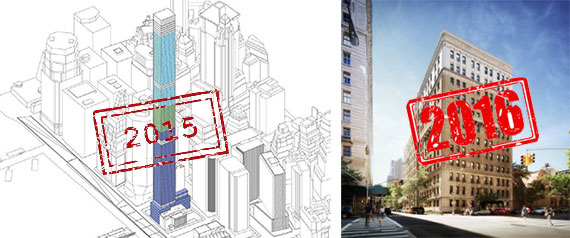It’s getting lonely at the top.
As the market for land sales in Manhattan has cooled amid a real estate slowdown, air rights trades have plummeted, an analysis by The Real Deal shows.
The dollar volume spent on Manhattan air rights through the end of September totaled $70.69 million, according to a TRD review of public records. That sum was down nearly 74 percent from the $269.78 million spent on deals that closed through the first nine months of 2015.
That decline went along with a big drop in Manhattan land trades, which fell to $2.3 billion in the third quarter, a 55 percent year-over-year drop from about $5.2 billion, according to Cushman & Wakefield [TRDataCustom] data. The decrease in activity comes amid a luxury condo glut and a much tighter environment for financing new projects.
But the slowdown is even more noticeable in the market for air rights, which can sometimes make or break a deal.
Eric Anton, an investment sales broker at HFF, said he would generally expect to see the land and air-rights markets expand and contract proportionally with one another.
But when it comes to larger projects, he said, developers can sometimes make the site work without the additional air rights, as opposed to smaller sites that may be more dependent on the additional square footage in order to pencil out.
“The larger sites tend to be big enough that they don’t need the air rights,” Anton said. “They’re sort of the cherry on top.”
Developers planning tall buildings are sometimes willing to pay top dollar for the additional air rights, because they’ll be used for the most expensive units with the best views. But in a market where there’s uncertainty about demand for those pricy units, developers may be more reluctant to cough up a premium for those rights.
City Center Real Estate president Robert Shapiro, an air-rights expert, said certain pockets of the city are still seeing trades at premium prices. Near the High Line in West Chelsea, deals are getting done around $750 and $800 per square foot.
“If you can find them,” he said. “That’s the trick.”
Shapiro added that in districts with height limitations, developers are often better off buying more land than air rights.
“In that case, you’re probably better off loading a building with bigger bulk than a tower on a base,” he said.
TRD’s analysis captured all recorded air rights transactions in Manhattan, but there are generally some air rights transactions every year that do not appear in property records.
The largest single air-rights deal last year was Howard Hughes’ purchase of roughly 150,000 square feet of rights from Edison Properties for $64.6 million, or about $438 per square foot, for its development site at 80 South Street.
The developer had assembled enough square footage to build an 820,000-square-foot supertall tower that would rise more than 1,000 feet near the South Street Seaport, before it sold the property to investment firm China Oceanwide Holdings for $390 million.
The transaction was one of 10 eight-figure deals closed during the same period last year, including the $29 million the Collegiate Churches of New York paid to expand its residential conversion of the Collegiate School campus at 260 West 78th Street.
This year, however, things have been more sparse. There have been only three air-rights trades greater than $10 million as of the end of the third quarter. The largest in the list was Extell Development’s purchase of 42,378 square feet of air rights for $20.13 million, or $475 per square foot, from the Helen Hayes Theater for its site at 1710 Broadway, which the firm plans to develop into a 60-story hotel-condo with partner C&K Properties.
